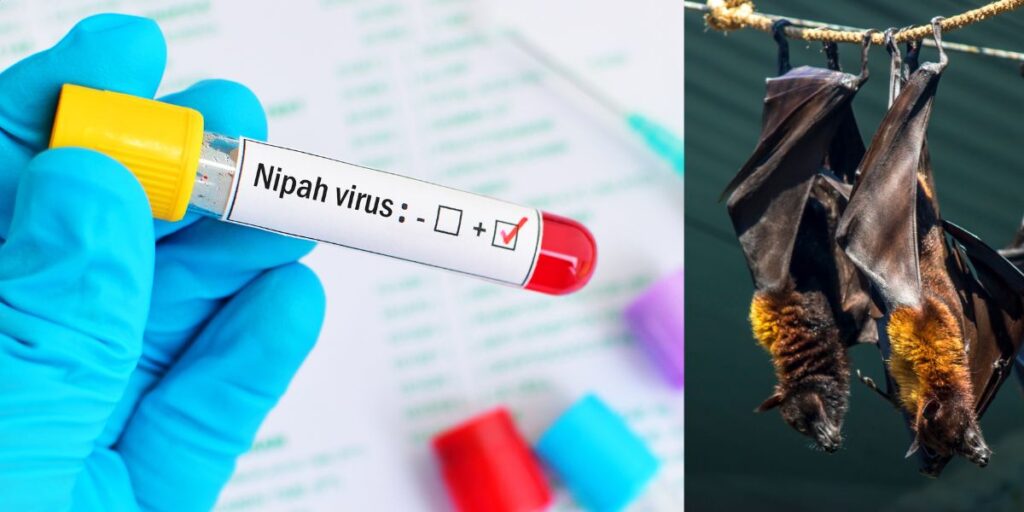Understanding Nipah Virus
Nipah Virus Overview
Nipah virus (NiV) is a zoonotic virus, meaning it can be transmitted from animals to humans. This virus can also spread through contaminated food or directly between people. When it infects humans, it can cause a range of illnesses, from no symptoms at all to severe respiratory illness and fatal encephalitis. It’s a significant concern for public health due to its ability to cause severe disease and death in both humans and animals.
Past Outbreaks
Nipah’s Origins
The Nipah virus was first identified in 1999 during an outbreak among pig farmers in Malaysia. Fortunately, no new outbreaks have been reported in Malaysia since then. However, Bangladesh has experienced nearly annual outbreaks since 2001, and the virus has periodically appeared in eastern India. Moreover, various bat species across several countries, including Cambodia, Ghana, Indonesia, Madagascar, the Philippines, and Thailand, have reported the presence of the virus.
Transmission
How It Spreads
The initial outbreak in Malaysia primarily resulted from direct contact with sick pigs or their contaminated tissues. Later outbreaks in Bangladesh and India were linked to the consumption of fruits or fruit products contaminated with urine or saliva from infected fruit bats.
Human-to-human transmission has also occurred among family members and caregivers of infected patients. In some instances, transmission has even taken place within healthcare settings.
Signs and Symptoms
Recognizing Nipah Infection
Symptoms of Nipah infection can range from mild to severe. Initial signs include fever, headaches, muscle pain, vomiting, and sore throat. As the disease progresses, individuals may experience dizziness, altered consciousness, and neurological symptoms indicating acute encephalitis. Severe cases can involve atypical pneumonia and acute respiratory distress, potentially leading to coma within 24 to 48 hours. Survivors of acute encephalitis may face long-term neurological complications, with around 20% developing issues like seizure disorders and personality changes. The case fatality rate varies but can be as high as 75%.
Diagnosis
Challenges in Diagnosis
Nipah virus infection presents nonspecific symptoms initially, making it difficult to diagnose accurately. This complicates outbreak detection and response efforts. To confirm cases, healthcare professionals utilize diagnostic tests such as real-time polymerase chain reaction (RT-PCR) and enzyme-linked immunosorbent assay (ELISA) for antibody detection. Challenges arise from the timing and quality of sample collection and transportation to laboratories. Other tests, like PCR assays and virus isolation by cell culture, are also used.
Treatment
No Specific Treatment
Currently, there are no specific drugs or vaccines for the Nipah virus. Intensive supportive care is recommended to address severe respiratory and neurological complications.
Natural Host: Fruit Bats
Nipah’s Natural Hosts
Fruit bats, particularly those from the Pteropus genus, are the natural hosts for the Nipah virus. Interestingly, these bats do not display symptoms of the disease. Pteropus bats in various countries, including Australia, Bangladesh, Cambodia, China, India, Indonesia, Madagascar, Malaysia, Papua New Guinea, Thailand, and Timor-Leste, have shown evidence of Henipavirus infection.
Nipah Virus in Domestic Animals
Nipah in Animals
Nipah virus outbreaks in pigs and other domestic animals, such as horses, goats, sheep, cats, and dogs, were first reported during the 1999 Malaysian outbreak. Pigs are highly contagious during the incubation period, potentially exhibiting symptoms like fever, labored breathing, and neurological issues. Investigators should prioritize the investigation of suspected cases in pigs, particularly when these cases exhibit unusual symptoms such as an unusual barking cough or when there are concurrent cases of encephalitis in humans.
Prevention
Preventing Nipah Transmission
Preventing Nipah virus transmission involves several key strategies:
- Controlling Nipah in Pigs: Routine cleaning and disinfection of pig farms are crucial, and suspected outbreaks should lead to immediate quarantines and, if necessary, culling of infected animals.
- Reducing Risk in People: Raising awareness about risk factors is vital. This includes avoiding bat-to-human transmission by protecting date palm sap collection sites and thoroughly washing and peeling fruits. For animal-to-human transmission, protective clothing should be worn when handling sick animals or their tissues.
- Human-to-Human Transmission: Close contact with infected individuals should be avoided. Regular handwashing is essential when caring for or visiting sick people.
- Infection Control in Healthcare Settings: Healthcare workers should implement standard infection control precautions, including contact and droplet precautions when needed.
- Laboratory Handling: Samples from suspected cases should be handled by trained staff in well-equipped laboratories.
By following these guidelines and raising awareness, we can reduce the risk of Nipah virus transmission and better protect public health.
The study has been published in World Health Origination
Also Read: US Astronaut Makes Space History: Sets NASA Record For Longest Solo Mission!






